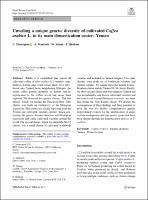Unveiling a unique genetic diversity of cultivated Coffea arabica L. in its main domestication center: Yemen
Abstract
Whilst it is established that almost all cultivated coffee (Coffea arabica L.) varieties originated in Yemen after some coffee seeds were introduced into Yemen from neighboring Ethiopia, the actual coffee genetic diversity in Yemen and its significance to the coffee world had never been explored. We observed five genetic clusters. The first cluster, which we named the Ethiopian-Only (EO) cluster, was made up exclusively of the Ethiopian accessions. This cluster was clearly separated from the Yemen and cultivated varieties clusters, hence confirming the genetic distance between wild Ethiopian accessions and coffee cultivated varieties around the world. The second cluster, which we named the SL-17 cluster, was a small cluster of cultivated worldwide varieties and included no Yemen samples. Two other clusters were made up of worldwide varieties and Yemen samples. We named these the Yemen Typica- Bourbon cluster and the Yemen SL-34 cluster. Finally, we observed one cluster that was unique to Yemen and was not related to any known cultivated varieties and not even to any known Ethiopian accession: we name this cluster the New-Yemen cluster. We discuss the consequences of these findings and their potential to pave the way for further comprehensive genetic improvement projects for the identification of major resilience/adaptation and cup quality genes that have been shaped through the domestication process of C. arabica.
Keywords
Is part of
Genetic Resources and Crop Evolution (2021)
URI (Permanet link to cite or share this item)
https://doi.org/10.1007/s10722-021-01139-yhttps://repositorio.catie.ac.cr/handle/11554/10332
Collections
- Publicaciones y documentos [4419]


